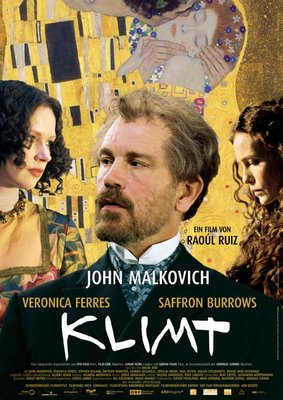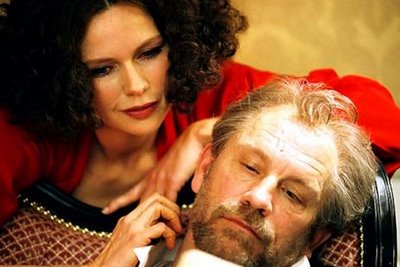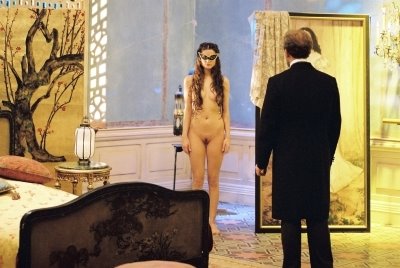My recent cinema viewing cannot be done justice through my usual practice of listing the last five films I’ve watched on the side-bar. To begin with, I’ve been attending the 15th Brisbane International Film Festival, and I bought two ‘Take Five’ passes, so the films I saw just last week would have already dropped off the list if I’d been listing them as per usual. As it is, I think I’m going to go back and just list the BIFF as one entry, that is if I can retrieve, either from my memory or an old index page, the films I watched before the Festival started.
The purpose of this post is to give due respect to the films I’ve seen at BIFF, and maybe create a record to serve my own memory. I don’t really want to review them in any concerted way, just comment on what I got out of them. On another level, it intrigues me that any number of people can attend an event like BIFF and have entirely distinct, or parallel, experiences of the Festival. This is my BIFF universe.
Klimt
 The first film I saw was Klimt, a kind of surrealist bio-pic of the eponymous artist, by Chilean director, Raul Ruìz. If Klimt’s work has become a hollow currency through mass-produced popular culture in the form of prints that grace the walls of aspiring intellectuals, then Ruìz’s film portrays an artist whose vision was at odds with the political elite of his day. It becomes clear that Gustav Klimt depended upon the acceptance and patronage of the Viennese government to continue inhabiting and working in Vienna. Despite this state of affairs, Klimt is not inclined to flatter those upon whose good will he depends. He is only saved, it seems, from being banished, because he wins an award or two.
The first film I saw was Klimt, a kind of surrealist bio-pic of the eponymous artist, by Chilean director, Raul Ruìz. If Klimt’s work has become a hollow currency through mass-produced popular culture in the form of prints that grace the walls of aspiring intellectuals, then Ruìz’s film portrays an artist whose vision was at odds with the political elite of his day. It becomes clear that Gustav Klimt depended upon the acceptance and patronage of the Viennese government to continue inhabiting and working in Vienna. Despite this state of affairs, Klimt is not inclined to flatter those upon whose good will he depends. He is only saved, it seems, from being banished, because he wins an award or two.There is no coherent narrative in Klimt, a decision that is motivated by the perspective of Klimt as he is being treated for syphilis. While the mercury treatment is cause enough to addle anyone’s brains, the point-of-view is also an attempt to convey Klimt’s artistic vision. The BIFF catalogue describes this as ‘kaleidoscopic, mysterious and passionate’. ‘Mysterious’ could simply be the charitable interpretation of what might otherwise be deemed obscure, but, apparently, as far as Ruìz’s films go, this one is accessible. ‘Kaleidoscopic’ is probably a more accurate description than ‘impressionistic’, which is the term I initially wanted to use to describe the disjointed narrative. But I suppose there isn’t an entirely coherent picture of either the film or the artist that emerges in the end, and I guess it’s best to avoid confusing your artistic movements.

Visually, the film is impressive. Distorted and mirrored images convey a sense of the complexity of Klimt as an individual. For me, John Malkovich in the lead role was a bit of a distraction. I had high hopes, since I had just seen him play Charles II in The Libertine, and for once he hadn’t used that voice he does: slightly effete with lots of disdainful pauses. Unfortunately, that voice was back in Klimt. In spite of this irritation, the portrait of Klimt could be deemed successful. The film avoided the usual pitfalls of bio-pics where the artiste is a misunderstood genius. Klimt sketches a man who is difficult and sexually promiscuous (and prolific, if the reports of the numbers of children he fathered are accurate) ; he wasn’t terribly likeable if you weren’t in his favour.
 Most importantly, I think, the film pays attention to Klimt’s art. Its beauty is suitably fêted in the representation of the artist models, the golden glow that suffuses every frame, and in one glorious moment where gold leaf flies into the air and continues to rain down long after it would have stopped in a realist picture.
Most importantly, I think, the film pays attention to Klimt’s art. Its beauty is suitably fêted in the representation of the artist models, the golden glow that suffuses every frame, and in one glorious moment where gold leaf flies into the air and continues to rain down long after it would have stopped in a realist picture.
'A Parallel Universe' will be continued...
No comments:
Post a Comment